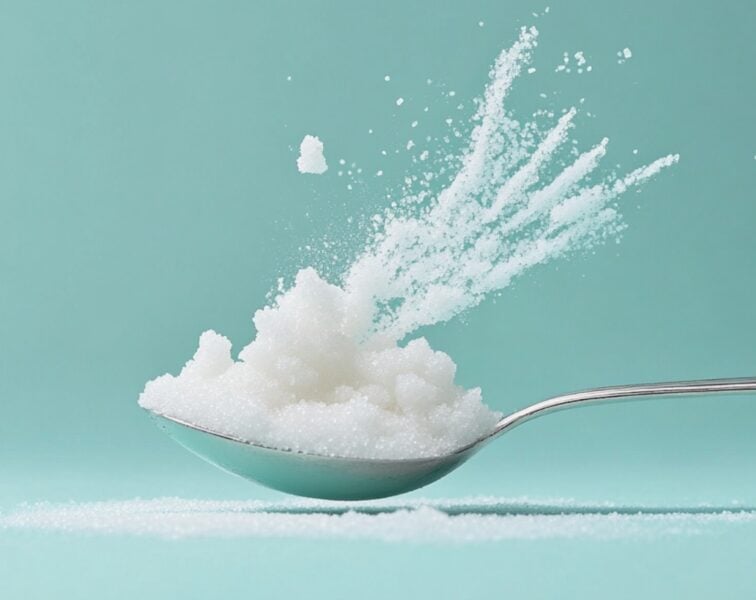Earlier this month, a study published in the European Heart Journal reported that the common sugar substitute xylitol increased risk of blood clots and was associated with elevated risk of adverse cardiovascular events.¹ The Washington Post, CNN, and other mainstream news outlets quickly latched on to the story, fueling another round of widespread alarm and confusion.
But as I read through the research article, I couldn’t help but notice that it seemed eerily familiar. The methods, the results, even the design of the figures – I could have sworn I’d seen this before. Then I looked at the list of authors, and it struck me. I had seen (and analyzed) this paper before. About a year ago, the same research group had published similar results on erythritol,² a sweetener within the same class of compounds as xylitol. And after comparing my analysis of that study with the results published this month, I found that the two papers also resembled each other in another way – namely, their similar shortcomings.
A link between circulating xylitol and CV risk
As in the erythritol study, investigators Witkowski et al. identified xylitol as a molecule of interest by analyzing fasting plasma samples from 1,157 participants who had undergone elective diagnostic cardiac evaluations (the “discovery cohort”). By conducting untargeted metabolomics analyses on these samples, the authors sought to determine which circulating compounds were associated with major adverse cardiovascular events (MACE: death, heart attack, or stroke) over a 3-year follow-up period. Regression analyses revealed that plasma xylitol levels were positively associated with MACE risk after adjusting for cardiovascular risk factors such as age, blood pressure, lipid levels, smoking status, and levels of the inflammation marker hsCRP (HR=1.64; 95% CI: 1.05-2.56), P<0.05).
The authors then validated this result in another, independent cohort (n=2,149) by conducting xylitol-specific metabolomic assays in fasting plasma samples and analyzing associations with MACE in 3-year follow-up data. Again, results showed a link between circulating xylitol levels and MACE incidence. Those in the highest xylitol tertile (T3) had a 57% higher risk of MACE than those in the lowest tertile (T1) after adjusting for other risk factors (HR=1.57; 95% CI: 1.12-2.21), P<0.01). (Differences in risk between tertiles 1 and 2 were not significant.)
Xylitol and blood clotting
Witkowski et al. then evaluated the possibility that xylitol might contribute to MACE risk by enhancing blood clotting, thus increasing risk of vascular blockage. They applied varying concentrations of xylitol or control solution to human platelet-rich plasma, and when combined with application of known platelet-activating factors, xylitol was found to enhance platelet activation and aggregation (early steps in blood clot formation) in a dose-dependent manner. However, it is worth noting that these experiments were only performed using xylitol levels near and above the upper limit of concentrations seen in human fasting plasma samples. As more direct evidence of xylitol effects on blood clotting, the authors injected mice with xylitol or control solution and found that xylitol resulted in faster clot formation – though again, the xylitol concentration used in this experiment was near the upper limit of physiological ranges observed in the human cohorts.
Case closed?
These results make a case for a correlation between circulating xylitol and MACE risk, and they indicate that such an association may reflect an effect of xylitol in promoting blood clotting (albeit only at the very highest xylitol levels observed in fasting plasma samples). Still, the authors also demonstrate that everyone is in danger of extraordinarily high circulating xylitol levels if the sweetener is included in one’s diet. The investigators had ten healthy participants consume a single xylitol-sweetened drink, which they note as being comparable in xylitol content to a pint of xylitol-sweetened ice cream. They then found that circulating levels spiked by as much as 1000x baseline values within 30 minutes – well over the minimum concentration at which clotting effects had been observed. Levels returned to baseline ranges within 4-6 hours after ingestion of the xylitol beverage.
So can we conclude from these data that xylitol consumption increases risk of blood clots and cardiovascular events, end of story? Absolutely not.
Diet isn’t the only source of xylitol
The problem with interpreting these results as a condemnation of xylitol consumption is that diet isn’t the only source of circulating xylitol. This compound is also produced by our own bodies through a process known as the glucuronate pathway, one of the pathways by which we metabolize glucose. So how did the authors ensure they were investigating the relationship between dietary xylitol intake and MACE risk?
They didn’t. The investigators did not collect any data on xylitol intake from their human cohort, so we have no way of correlating consumption with MACE risk because we have no way of knowing which participants were regularly consuming xylitol-containing foods. And although xylitol is currently a very common sweetening additive, Witkowski et al. note that the majority of their study participants were enrolled prior to xylitol’s widespread use, suggesting that circulating levels measured in their observational cohort may not be attributable to dietary intake.
But for the sake of argument, let’s assume that all participants were exposed regularly through diet. Associations between circulating xylitol levels and MACE incidence derived from plasma samples taken after an overnight fast (>12 hours, according to the study protocol), whereas the results of xylitol time course experiments showed that the spike in circulating xylitol following dietary ingestion returns to baseline within six hours. This suggests that the reported positive association between xylitol and MACE risk were instead the result of endogenous production. Indeed, the authors point this out themselves:
The rapid rate of xylitol excretion observed in healthy volunteers with return to near baseline (fasting) levels within hours following ingestion of a significant dietary exposure suggests that the plasma levels observed in our observational (validation) cohort represent variations in endogenous production/levels and not food intake.
In other words, this study provides no evidence whatsoever that dietary xylitol intake has any association with MACE, yet still the authors insist on linking the two in their conclusions, claiming that their results evince “a direct effect of the low-calorie sweetener xylitol on platelet function and thrombosis potential.”
Causality is unclear
So we don’t know about dietary xylitol, but can we at least conclude that circulating xylitol – regardless of the source – is harmful? Again, the answer is a hard “no.”
As with most observational studies, Witkowski et al.’s human investigations do not demonstrate causality. The authors present these data as evidence that xylitol raises MACE risk, but the fact that our bodies produce xylitol as a result of metabolic processes introduces a very high likelihood of a “third variable problem” – a situation in which two unrelated variables appear to be correlated because they are both influenced by a third, unknown variable. Glucuronate pathway activity – and therefore xylitol production – is elevated with diabetes, liver disease, and other inflammatory and metabolic derangements which might impact cardiovascular risk independently of effects on xylitol production.3,4 In other words, circulating xylitol is a covariate of countless other variables with well-established connections to cardiovascular risk and may simply be a read-out of overall metabolic health with no causal role in disease.
The authors attempted to establish causality through their mechanistic experiments in mouse models and using platelet-rich plasma. Mice, however, are a notoriously poor model for human cardiovascular disease. Their lipid biology has key differences from that of humans, and unlike humans, they almost never develop coronary artery disease. Mice also demonstrated poor absorption of dietary xylitol in this study, necessitating injection of xylitol solutions, an exposure route which mimics neither human dietary intake nor human endogenous production. Indeed, in discussing their results, the authors devote substantial attention to differences in xylitol metabolism across mammalian species, underscoring the limited reliability of their findings in mice.
In vitro experiments are often even less reliable as a model because they lack any whole-body context. Further, platelet-rich plasma is not representative of the concentration of platelets normally found in human blood, so not only did the investigators need to use unusually high concentrations of xylitol to see an effect on platelet aggregation, but they also needed unusually high concentrations of platelets.
Rings a bell, but not an alarm
First erythritol, now xylitol. This research group followed the same flawed design and ended up with the same flawed conclusions. SSDD – same [study], different day.
Indeed, just as a fun way to prove the similarity between these papers and their flaws, I was able to reuse my earlier analysis nearly verbatim – so if you’re experiencing your own sense of déjà vu in reading this, rest assured that you’re certainly not alone.
At best, this work shows that endogenous xylitol correlates with – but doesn’t necessarily contribute to – cardiovascular risk. Far from condemning xylitol as an ingredient in foods and beverages, these data provide no insight whatsoever on potential negative effects of dietary xylitol intake, whereas other evidence (some of which I discussed in a premium article on sugar substitutes more broadly) indicates that xylitol may even offer advantages for health.
So in summary, this work should ring a few bells – but there’s no need for it to ring any alarms.
For a list of all previous weekly emails, click here.
References
- Witkowski M, Nemet I, Li XS, et al. Xylitol is prothrombotic and associated with cardiovascular risk. Eur Heart J. Published online June 6, 2024. doi:10.1093/eurheartj/ehae244
- Witkowski M, Nemet I, Alamri H, et al. The artificial sweetener erythritol and cardiovascular event risk. Nat Med. 2023;29(3):710-718. doi:10.1038/s41591-023-02223-9
- Stirpe F, Comporti M. Regulation of ascorbic acid and of xylulose synthesis in rat-liver extracts. The effect of alloxan-diabetes on the glucuronic acid pathway. Biochem J. 1965;97(2):561-564. doi:10.1042/bj0970561
- Ho A, Sinick J, Esko T, et al. Circulating glucuronic acid predicts healthspan and longevity in humans and mice. Aging . 2019;11(18):7694-7706. doi:10.18632/aging.102281




